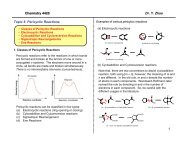crude trimyristin - Chemistry
crude trimyristin - Chemistry
crude trimyristin - Chemistry
You also want an ePaper? Increase the reach of your titles
YUMPU automatically turns print PDFs into web optimized ePapers that Google loves.
PROCEDURE<br />
Weigh out 10 g of ground nutmeg and place it in a 500 mL round bottom flask. Add 90<br />
mL of hexane and a few boiling chips and set up an apparatus for reflux (See the figure on<br />
page 125) . Reflux the hexane-nutmeg mixture, using a steam bath (see Safety: above) as the<br />
source of heat, for 30 min. Determine the mass of your clean, dry 250 mL round bottom<br />
flask, containing a few boiling stones. Remove the mixture from the steam bath (dry any<br />
water from the flask and condenser before removing the condenser from the flask) and while it<br />
is still warm, filter off the residue of the nutmeg by gravity filtration, collecting the filtrate in the<br />
preweighed 250 mL round bottom flask. Rinse out the flask in which you did the original<br />
extraction (i.e. the 500 mL flask) with about 5-10 mL of fresh hexane and filter the washings into<br />
the 250 mL flask. Dispose of the filter paper in the dump in the fume hood.<br />
Set up the apparatus for simple distillation (See the figure on page 124) and distil off the<br />
hexane using a steam bath. Record the temperature (to the nearest 0.5 °C) when the first drop<br />
of distillate is collected in the collection flask and record the highest temperature reached during<br />
the distillation. This will be the collection range for the distillation. Continue heating for 5<br />
minutes after the last of the hexane has distilled over. Dry any water from the distillation flask<br />
and connecting adapter. Dispose of the distilled hexane in the appropriate dump in the fume<br />
hood (make sure you know which flask contains the hexane). Remove the flask containing the<br />
<strong>crude</strong> product and weigh the flask. Record the mass of <strong>crude</strong> product. At this point, the<br />
sample likely contains a trace of hexane and will therefore show an artificially high mass. Leave<br />
the flask containing the <strong>crude</strong> product in your locker for a week (uncorked).<br />
After the product has dried for a week, determine the mass of the flask. Record the<br />
mass. Did the mass change over the week? Store this round bottom flask in your locker until<br />
it is purified in the next lab period.<br />
- 4 -<br />
REPORT<br />
In the “purpose section”, clearly explain the purpose of the main steps in this<br />
experiment. In the “discussion section”, comment on the change in product mass from week<br />
one to week two. Calculate the percentage recovery of product (be sure to base this on the<br />
mass of product after it has dried for a week) and compare this to the expected value (see<br />
note 2). List sources of error to account for any discrepancy.









